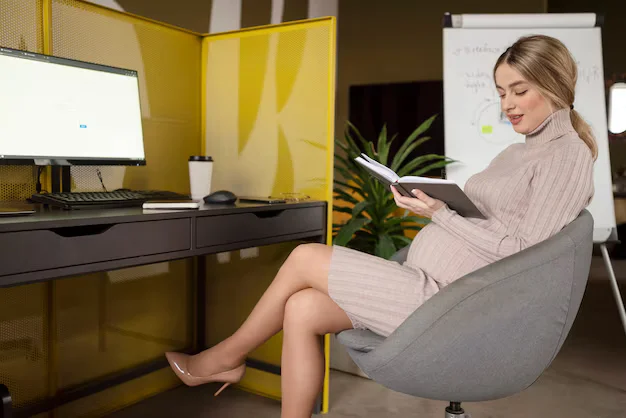Understanding the Benefits of an Ergonomic Kneeling Chair
Why Posture Matters: The Science Behind Ergonomics
In the realm of contemporary work environments, the significance of ergonomic design has garnered empirical backing and widespread acknowledgment. Proper posture not only enhances comfort but also promotes long-term health benefits. When individuals sit for extended periods, they often adopt postures that compress the spine, strain muscles and lead to chronic pain syndromes. Ergonomic kneeling chairs are designed to mitigate these issues by promoting a more open hip angle which keeps the back straight and encourages alignment of the spine. In essence, these chairs redistribute weight away from the spine and lower back, translating to reduced discomfort. The integrated knee support shifts some of the pressure off the lumbar region while enhancing core support by engaging abdominal muscles. Moreover, a recent study by the American Journal of Industrial Medicine has evidenced that proper ergonomics in the workplace decreases the incidence of musculoskeletal disorders, making a compelling case for chairs that enhance posture.
Boost Your Productivity: How Your Chair Affects Work Performance
Productivity is intrinsically linked to one’s physical state and mental clarity. An ergonomic kneeling official chair allows for a posture that not only supports the body but also fosters better focus and concentration. Research conducted at the University of Cincinnati indicated a significant relationship between physical comfort and cognitive performance. When comfort levels are low due to poor chair design, distractions arise—frequent adjustments, discomfort from pressure points, and an inability to focus lead to diminished work output. Kneeling chairs facilitate a conducive environment for working, allowing for engagement in projects without the constant irritation of aches and stresses on the body. A significant number of users report increased energy levels and a better sense of clarity, affirming that a supportive chair can be transformative for workflow. Hence, upgrading to an ergonomic kneeling chair can be seen not only as a personal investment in health but also as a strategic move to enhance overall work performance.
Reducing Pain and Discomfort: A Solution for Sedentary Lifestyles
As modern work culture pivots towards more sedentary lifestyles, with many spending over 8 hours a day sitting in office chairs, the prevalence of discomfort and pain has escalated. Ergonomic kneeling chairs provide a solution to this dilemma by inspiring a more active sitting posture, which can help alleviate the discomfort associated with prolonged sitting. They inherently encourage movement by allowing users to shift their body weight between the seat and knees, promoting circulation and reducing the risks tied to static postures. Several testimonials and case studies have illuminated how office workers and creatives alike have diminished back pain, improved circulation, and even addressed other physical ailments through the adoption of kneeling chairs. This design not only caters to supporting a healthy spine but also addresses the sedentary lifestyle that has become the norm in many industries, providing a proactive approach to health and comfort.
Choosing the Right Ergonomic Kneeling Chair for You
Explore the Different Styles: From Traditional to Modern Designs
When it comes to selecting an ergonomic kneeling chair, one must consider not only the practicality but also the aesthetics that suit one’s workspace. The market offers a variety of styles, from traditional wooden models to sleek, modern designs with various features. Traditional chairs often embrace simplicity, featuring wood construction that is aesthetically pleasing and durable. These chairs align with homespun or rustic office themes and add a touch of warmth to the workspace. On the other hand, modern designs often incorporate advanced materials like breathable fabrics, memory foam cushions, and even adjustable mechanisms that allow for personalized settings. Innovative designs may offer features such as a tilting seat, customizable height settings, or wheels for mobility. The selection between styles should take into consideration the space constraints of your office, the décor, and personal comfort preferences, ensuring that you choose a kneeling chair not just based on functionality but also how well it complements your environment in enhancing both aesthetics and practicality.
Material Matters: Finding the Right Fabric and Cushioning
The materials used in constructing an ergonomic kneeling chair should be thoughtfully considered, as they play a crucial role in ensuring comfort, durability, and ease of maintenance. Cushions should ideally consist of high-density foam, providing adequate support while allowing for long periods of sitting without discomfort. Breathable fabrics are essential to prevent overheating and sweating during extended use, making mesh and cotton blends particularly appealing options. Some users may appreciate chairs lined with antimicrobial covers for easy maintenance and to promote hygiene, particularly in shared workspaces. Additionally, the wood type used in the construction of the chair can significantly impact its longevity and resistance to wear. Chairs made with high-quality hardwood often outlast those made from particleboard or lower-tier materials. Taking the time to assess the quality of materials will pay dividends in terms of comfort and durability over the life of your chair.
Setting Your Budget: What to Expect at Different Price Points
When it comes to purchasing an ergonomic kneeling chair, understanding your budget is essential. Prices can vary significantly, ranging from $50 to upwards of $500 or more, depending on the brand, features, and overall build quality. Lower-end chairs often offer basic functionality with minimal adjustment options, making them suitable for infrequent use or for those who are just beginning to explore ergonomic solutions. Mid-range chairs, typically costing between $150 and $300, often provide a good balance between features and price, with options for height adjustment, better cushioning, and improved durability. At the higher end of the spectrum, premium chairs feature advanced ergonomic designs, customizability, and high-quality materials that ensure lasting comfort and support. It is crucial to consider how often the chair will be used, its intended duration of use, and whether it will be complemented by additional ergonomic accessories, as investing in a high-quality chair can be more economical in the long run by reducing medical costs associated with poor posture.
How to Properly Use Your Kneeling Chair for Maximum Effectiveness
Adjust Your Position: Finding the Perfect Angle for Comfort
Adopting the right posture while using an ergonomic kneeling chair is paramount to reaping its benefits. Start by adjusting the height of the chair so that your knees are located slightly below your hips. This positioning allows for a comfortable slope that keeps your spine aligned and provides lumbar support, reducing stress on your back. It is advised to keep your back straight and shoulders relaxed while ensuring your neck aligns with your head. Regularly check your positioning throughout your work, as it’s easy to slip into other postures over time. As with any ergonomic solution, it’s encouraged to take breaks every 30 to 60 minutes to switch positions or stand; this active approach not only refreshes the body but also stimulates blood flow, keeping energy levels stable during prolonged intervals of work.
Integrating Movement: Combining Kneeling with Other Seating Options
The integration of a kneeling chair into your workspace doesn’t have to exclude traditional seating solutions. In fact, alternating between a kneeling chair and a standard office chair can provide a dynamic work environment that prevents fatigue and boredom. For example, a productive approach could involve using the kneeling chair for focused tasks, such as writing or computer work, while reserving your standard chair for meetings or casual tasks. This rotational method capitalizes on the benefits of both chair types, allowing the user to experience the improved posture provided by the kneeling chair while enjoying the familiarity of traditional seating. Additionally, consider incorporating standing desks into the mix or using balance boards during standing periods, as these further promote movement and can cultivate creative energy throughout your day.
Creating a Balanced Workspace: Desk Height and Accessories to Consider
An ergonomic kneeling chair functions best when paired with an appropriately designed workspace. The height of your desk should align with your body posture when seated; ideally, your elbows should rest comfortably at a 90-degree angle while typing, with your wrists straight as you engage with your keyboard. Furthermore, ergonomic accessories such as footrests, desk organizers, and monitor stands can enhance the overall functionality of your workspace. A footrest can offer additional support for your feet while kneeling, further promoting blood circulation and reducing strain. Additionally, positioning your monitors at eye level ensures that you maintain a natural neck position, which is crucial for reducing strain on both your neck and back. Creating a balanced workspace is about ensuring that every element—from chair to desk to ergonomic accessories—is harmonized, stimulating productivity while nurturing your long-term health.
Real-Life Transformations: Testimonials and Case Studies
Success Stories: How One Chair Changed My Work Life
Personal testimonials from users of ergonomic kneeling chairs often reveal an inspiring shift in work life. For instance, a marketing executive shared that after experiencing chronic back pain for years, she splurged on a kneeling chair without much expectation. Within weeks, she noted a significant reduction in pain and fatigue, prompting her to integrate more active stretches and movements into her daily routine. The chair not only transformed her physical state but also revitalized her workflow, leading to increased creativity and focus on projects. Such transformations underscore the potential of ergonomic chairs to instigate profound changes in how we experience daily tasks, shifting from a state of discomfort to one of empowerment and productivity.
Expert Insights: Ergonomists Weigh in on Kneeling Chair Benefits
Ergonomists concur that kneeling chairs have a distinctive place in the realm of workplace wellness. On examining user feedback, they observe that such chairs initiate a proactive approach to maintaining one’s physical well-being, particularly for individuals whose occupations demand long hours of sitting. Notably, ergonomists advocate for user education in effectively using these chairs, asserting that individuals can safeguard their health and boost performance by adhering to correct positioning techniques. Key points raised by experts also highlight the importance of customization—recognizing that individuals have diverse body shapes and preferences is paramount in making an optimal selection, thereby ensuring that each unique user experiences the full spectrum of benefits ergonomic kneeling chairs offer.
Before and After: Visual Transformations of Workspaces
Visual transformations of workspaces featuring ergonomic kneeling chairs provide heartening evidence of their impact. Users report an aesthetic overhaul as they integrate kneeling chairs into their environments, leading many to shed bulky, traditional office furniture in favor of minimalist, ergonomically designed replacements. Before-and-after images often depict transformed workstations emanating a modern, engaging, and inspirational energy—a reflection of enhanced productivity. Additionally, these visuals often illustrate essential enhancements such as better organization of desk accessories, improved lighting, and more spacious arrangements conducive to stimulation and creativity. The shift is more than physical; it signifies a profound mental transformation, inviting individuals to engage more fully in their work and lives.







